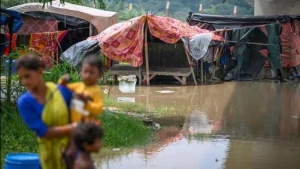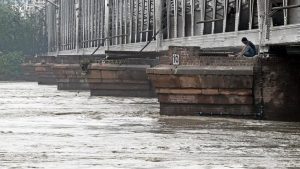New Delhi – For the first time in over two years, Yamuna Crosses Danger Mark Delhi has become a reality as the river surged past the critical threshold of 205.33 meters on Monday. This development has triggered immediate alarm across the capital, prompting Delhi’s Chief Minister Rekha Gupta to conduct urgent on-ground inspections of flood preparedness measures throughout the city.
The situation escalated rapidly as authorities confirmed that Yamuna Crosses Danger Mark Delhi reached 205.63 meters by Monday evening. The Central Water Commission has issued forecasts indicating the water level will continue rising, potentially breaching the 206-meter evacuation threshold by 2 AM Tuesday morning.
Immediate Impact on Vulnerable Communities

The crisis of Yamuna Crosses Danger Mark Delhi has immediately affected residents in low-lying areas, with Rasina Khatoon, 27, among the first to experience flooding impacts. Living in a makeshift tent in Sonia Vihar with her husband and three children, Khatoon witnessed water seeping into her home by evening, forcing her family to stack belongings on a charpoy in preparation for evacuation.
“At 3am today, we woke up to the sound of water rushing into our house,” Khatoon explained while nervously glancing at the swelling river. “We managed to save a few belongings, but most of our vegetables and other things were destroyed. Every year, it is the same story.”
Rapid Water Level Escalation


The situation where Yamuna Crosses Danger Mark Delhi developed swiftly throughout Monday. According to Central Water Commission data, the river flowed at 204.7 meters at 5 AM before rising dramatically. The water crossed 205 meters at 10 AM, breached the danger mark at 2 PM, and continued climbing into the evening hours.
This surge followed massive water discharges from the Hathnikund barrage in Haryana. Officials reported over 100,000 cusecs of water released for nearly 12 consecutive hours between 1 PM Sunday and 1 AM Monday, including a seasonal peak discharge of 178,996 cusecs at 4 PM.
Emergency Response and Evacuation Preparations
As Yamuna Crosses Danger Mark Delhi became reality, the Irrigation and Flood Control department mobilized 34 of its 40 boats for emergency response. Loudspeakers and microphones broadcast evacuation warnings across riverbanks, alerting residents to prepare for immediate relocation.
“We are expecting the river to touch 206 meters by around 2 AM. So evacuations may take place between 2 and 4 AM,” confirmed an Irrigation and Flood Control official. Authorities established that evacuations of families in low-lying areas would commence once the river crosses the 206-meter mark.
Annual Displacement Cycle for Riverbank Communities
The scenario where Yamuna Crosses Danger Mark Delhi represents an annual ordeal for floodplain families. In Yamuna Bazaar, where rickshaw drivers and daily wage earners reside in tarpaulin shelters, residents confirmed receiving government evacuation warnings.
Sanjay Sharma, 53, who operates a snack shop overlooking the river, stated, “They told us to keep our belongings safe and be ready to move at short notice. This is nothing new for us. We’ve evacuated many times over the years.”
Ram Sachin, 65, a rickshaw puller residing in Yamuna Bazaar for eight years, emphasized the community’s minimal possessions. “We don’t own much. A charpoy, a blanket, some clothes — that’s all. So when the river rises, we can shift instantly.”
Also Read: Wall Collapse Near Humayun Tomb; Investigation Exposes Fatal Negligence
Recent Migration and Vulnerability
At Sarai Kale Khan, Akhilesh Sada, 28, prepared for another relocation with his wife and three children. The family had arrived from Bihar just one month prior, establishing a tent under a bridge. “Our farm by the river is already submerged. If the water rises more, we may have to return to our village,” Sada explained.
Historical Context and Flood Patterns
The current situation where Yamuna Crosses Danger Mark Delhi evokes memories of the devastating July 2023 floods. That year, the river reached its highest-ever level of 208.66 meters following record discharges of 359,760 cusecs from Hathnikund. Over 23,000 people required evacuation as water inundated areas far beyond floodplains, including Mayur Vihar, ITO, Salimgarh bypass, and Civil Lines.
During the 2023 crisis, three major water treatment plants supplying 25% of Delhi’s drinking water shut down temporarily, severely impacting citywide water supplies. In contrast, last year’s peak reached only 204.38 meters, remaining below the warning level.
Statistical Analysis of Flooding Frequency


Irrigation and Flood Control department data reveals that over 63 years, Yamuna Crosses Danger Mark Delhi scenarios have occurred with notable frequency. The river has crossed its warning level in 53 years, the 205-meter mark in 43 years, and the 206-meter evacuation threshold in 14 years. The critical 207-meter mark has been breached only four times, most recently in 2023.
Ongoing Challenges and Community Resilience
As Yamuna Crosses Danger Mark Delhi continues developing, residents face familiar displacement patterns. Sharma from Yamuna Bazaar recalled the 2023 experience: “We stayed in relief tents on the roadside for weeks. Nobody who lived here will ever forget it.”
The situation where Yamuna Crosses Danger Mark Delhi represents both predictable annual occurrence and persistent danger for vulnerable communities. Rasina Khatoon summarized the dilemma: “We know we have to move every year, yet we have no choice. Our lives depend on this river, but it also takes everything from us. All we hope is that the damage is not too much this time.”
Officials continue monitoring the evolving crisis as Yamuna Crosses Danger Mark Delhi threatens thousands of residents dependent on riverbank livelihoods while preparing comprehensive evacuation and relief measures.

